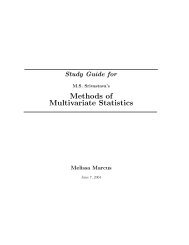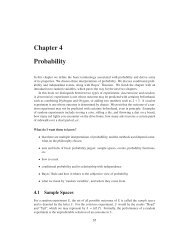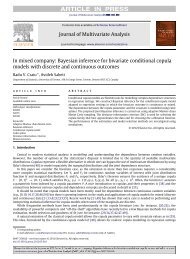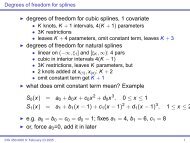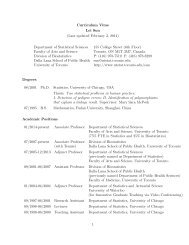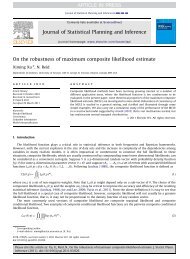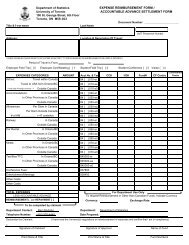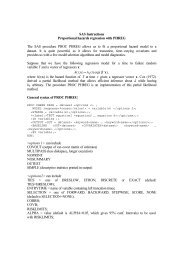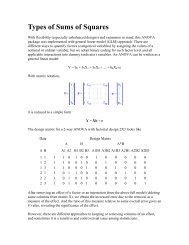Chapter 5 Discrete Distributions
Chapter 5 Discrete Distributions
Chapter 5 Discrete Distributions
Create successful ePaper yourself
Turn your PDF publications into a flip-book with our unique Google optimized e-Paper software.
5.6. OTHER DISCRETE DISTRIBUTIONS 129<br />
Example 5.24. ArandomvariablehasMGF<br />
( ) 31<br />
0.19<br />
M X (t) =<br />
.<br />
1 − 0.81e t<br />
Then X ∼ nbinom(size = 31, prob = 0.19).<br />
Note 5.25. As with the Geometric distribution, some books use a slightlydifferent definition of<br />
the Negative Binomial distribution. They consider Bernoulli trials and let Y be the number of<br />
trials until r successes, so that Y has PMF<br />
( ) y − 1<br />
f Y (y) = p r (1 − p) y−r , y = r, r + 1, r + 2,... (5.6.13)<br />
r − 1<br />
It is again not hard to see that if X denotes our Negative Binomial and Y theirs, then Y = X + r.<br />
Consequently, they have µ Y = µ X + r and σ 2 Y = σ2 X .<br />
5.6.3 Arrival Processes<br />
The Poisson Distribution<br />
This is a distribution associated with “rare events”, for reasons which will become clear in a<br />
moment. The events might be:<br />
• traffic accidents,<br />
• typing errors, or<br />
• customers arriving in a bank.<br />
Let λ be the average number of events in the time interval [0, 1]. Let the random variable X<br />
count the number of events occurring in the interval. Then under certain reasonable conditions<br />
it can be shown that<br />
−λ λx<br />
f X (x) = IP(X = x) = e , x = 0, 1, 2,... (5.6.14)<br />
x!<br />
We use the notation X ∼ pois(lambda = λ). The associated R functions are dpois(x,<br />
lambda), ppois, qpois, andrpois, whichgivethePMF,CDF,quantilefunction,andsimulate<br />
random variates, respectively.<br />
What are the reasonable conditions Divide [0, 1] into subintervals of length 1/n. APoisson<br />
process satisfies the following conditions:<br />
• the probability of an event occurring in a particular subinterval is ≈ λ/n.<br />
• the probability of two or more events occurring in any subinterval is ≈ 0.<br />
• occurrences in disjoint subintervals are independent.<br />
Remark 5.26. If X counts the number of events in the interval [0, t]andλ is the average number<br />
that occur in unit time, then X ∼ pois(lambda = λt), that is,<br />
−λt (λt)x<br />
IP(X = x) = e , x = 0, 1, 2, 3 ... (5.6.15)<br />
x!



